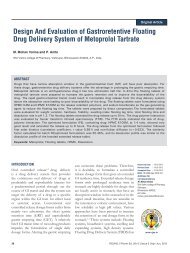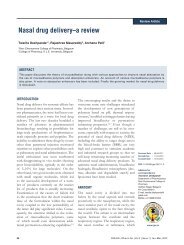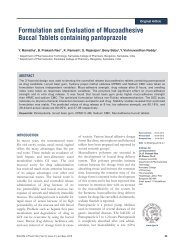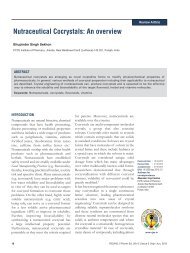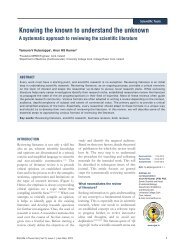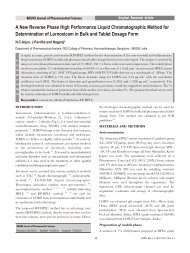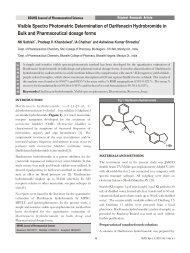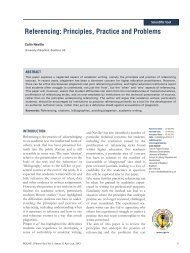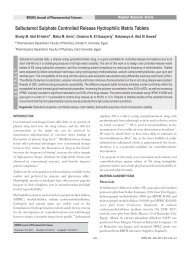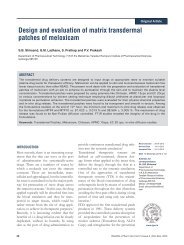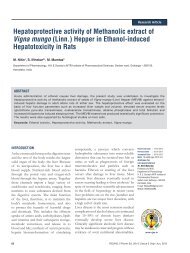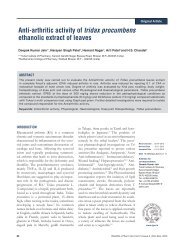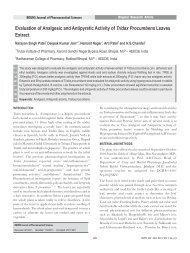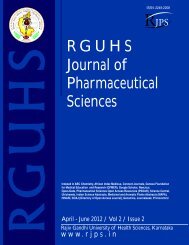Chitosan Loaded Mucoadhesive Microspheres of Gliclazide - Journal
Chitosan Loaded Mucoadhesive Microspheres of Gliclazide - Journal
Chitosan Loaded Mucoadhesive Microspheres of Gliclazide - Journal
Create successful ePaper yourself
Turn your PDF publications into a flip-book with our unique Google optimized e-Paper software.
A B S T R A C T<br />
RGUHS <strong>Journal</strong> <strong>of</strong> Pharmaceutical Sciences<br />
Assessment <strong>of</strong> Various Combination <strong>of</strong> Drugs Used in Treatment <strong>of</strong> Lower<br />
Respiratory Tract Infection<br />
3 1 2 1<br />
Imran Ahmad Khan* , Shobha Rani RH , Geeta S and Mahvash Iram<br />
1<br />
Department <strong>of</strong> Pharmacy practice, Al-Ameen college <strong>of</strong> Pharmacy, Bangalore-560027<br />
2<br />
Department <strong>of</strong> medicine, St. Martha's Hospital, Bangalore – 560001<br />
3<br />
Biocon India Ltd, Bangalore - 560100<br />
Both macrolides as well as cephalosporins are widely used in the treatment <strong>of</strong> various lower respiratory tract infections either alone or in<br />
combination. The most commonly prescribed macrolide is azithromycin, generally in combination with different cephalosporins. Thus<br />
arises the need to evaluate different combinations <strong>of</strong> azithromycin and cephalosporins generally prescribed and to compare their<br />
efficacy, safety (adverse drug reactions) as well as cost. A prospective study was conducted in the medicine ward at St. Martha's<br />
Hospital, Bangalore. Efficacy was determined based upon the clinical response (reduction in symptoms) and length <strong>of</strong> hospital stay.<br />
Safety was assessed by the occurrence <strong>of</strong> ADR and their severity. Cost <strong>of</strong> treatment was calculated by cost effective analysis. Data <strong>of</strong> 88<br />
patients was analyzed and it was observed that different combinations prescribed were azithromycin + cefotaxime, azithromycin +<br />
ceftriaxone and azithromycin + cefuroxime. The most commonly prescribed combination was found to be azithromycin with cefotaxime<br />
and it showed statistically significant difference in the reduction <strong>of</strong> clinical symptoms thereby indicating greater efficacy. 18% <strong>of</strong> the<br />
patients experienced ADRs which were mild in nature with none severe representing that all the combinations were safe. The cost<br />
effective analysis revealed that combination <strong>of</strong> azithromycin and cefotaxime was most economical.<br />
Keywords: Lower respiratory tract infection, Azithromycin, Cephalosporins, Combination<br />
INTRODUCTION<br />
Infections <strong>of</strong> the respiratory tract are very common due to the<br />
air pollution; especially those affecting the upper tract. Upper<br />
respiratory tract infections (URTIs) are usually caused by<br />
viruses and are rarely serious. They include common cold,<br />
tonsillitis, sore throat, sinusitis, laryngitis and croup. Lower<br />
respiratory tract infections (LRTIs) are usually more serious<br />
since they affect the breathing tubes (trachea and bronchi) and<br />
the lungs. Bronchitis, acute bronchiolitis and pneumonia are<br />
the various types <strong>of</strong> LRTI.<br />
Most upper respiratory tract infections are caused by viruses.<br />
Each time when a person gets cold it is caused by a slightly<br />
different virus, and once it is fought <strong>of</strong>f, body acquires<br />
immunity (resistance) to that particular virus. Lower<br />
respiratory tract infections are caused by both viruses and<br />
bacteria. Infection may begin with a virus, but if bacteria get<br />
into the lower respiratory tract, then it can cause more serious<br />
problems. LRTIs are more common in people with a weak<br />
immune system, such as geriatrics and those receiving<br />
1<br />
immunosuppressive treatment; for example, cancer patients .<br />
RGUHS <strong>Journal</strong> <strong>of</strong> Pharmaceutical Sciences<br />
Received: 21/6/2011, Modified: 12/7/2011, Accepted: 1/8/2011<br />
141<br />
Original Research Article<br />
Respiratory tract infections (RTI) are very common in the<br />
community and are one <strong>of</strong> the major reasons for<br />
2<br />
appointments to primary care physicians. The broad<br />
diagnosis <strong>of</strong> RTI includes the two principal sub-diagnoses <strong>of</strong><br />
lower respiratory tract infection (LRTI) and upper respiratory<br />
3<br />
tract infection (URTI) . Community-acquired lower<br />
respiratory tract infection is a common cause <strong>of</strong> acute illness<br />
in adults. The spectrum <strong>of</strong> disease ranges from mild mucosal<br />
colonization or infection, to acute bronchitis or acute<br />
exacerbation <strong>of</strong> chronic bronchitis (AECB) or chronic<br />
obstructive pulmonary disease (COPD), to overwhelming<br />
parenchymal infection in patients with community-acquired<br />
4<br />
pneumonia (CAP) . The term LRTI includes a wide range <strong>of</strong><br />
diseases which have different underlying pathologies and<br />
5,6<br />
etiologies, e.g. acute bronchitis and pneumonia . In the outpatient<br />
setting, LRTI accounts for the majority <strong>of</strong> all<br />
antibiotics prescribed, burdening healthcare budgets. In most<br />
<strong>of</strong> the adults with LRTI, the illness is self-limiting and its<br />
course will not be modified by antibiotic therapy, representing<br />
viral or clinically non-relevant bacterial diseases. However,<br />
failure to initiate an antibiotic therapy within four hours in<br />
cases <strong>of</strong> community acquired pneumonia (CAP) is associated<br />
7<br />
with an increased mortality rate. The major problem in the<br />
management <strong>of</strong> the LRTI is the inability to determine the<br />
8<br />
causative micro-organism in the majority <strong>of</strong> patients.<br />
RJPS, Jul - Sep, 2011/ Vol 1/ Issue 2



